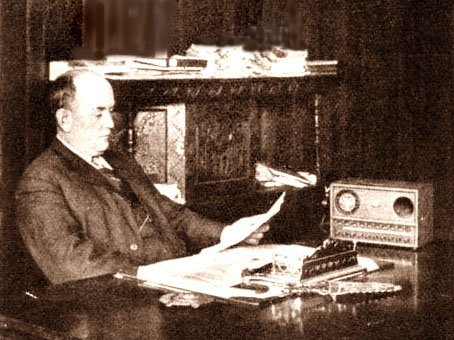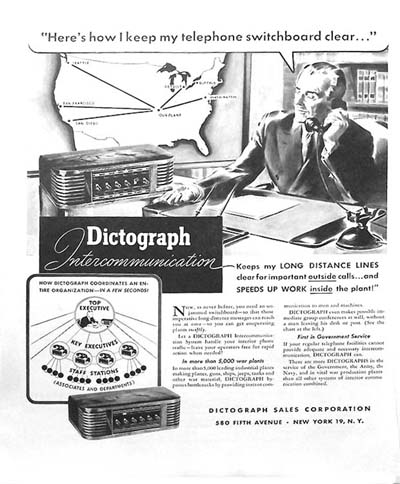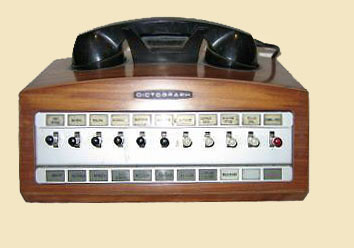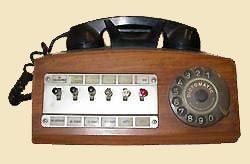| |||||
The DictographUpdated 10/2/2022 thanks to email sent by Mike Williams who worked for Dictograph telephones for many years and is familiar with all of the British models shown on this site.History
From 1902 to 1913 the Dictograph Products Company Inc., formed to handle the telephone part of the business, patented the basics of their system. The company and the Dictograph name were registered in 1907 by Turner and his financier, W Donnan. At this point it is necessary to clear up some confusion. The Dictograph was Turner's telephone system. The Dictaphone, a name often used in error to mean a Dictograph, was Edison's wax cylinder dictation machine. Too many references use the wrong name.
Above left: Earliest Dictograph logo used over the front of the Metrophone transmitter Above right: Later, pre-World War 1 logo
Above left: Metrophone internal, rear view Above right: Acousticon transmitter, on which the Metrophone was based. It was a carbon-ball and carbon-block transmitter. The later (1920s) version used multiple smaller carbon balls. Excellent photos of the interior detail of a Metrophone are available at
Mike Schult's website at The main drawback of the Dictograph system was the need to install extensive wiring from each position, and businesses were reluctant to change to such an expensive system to replace their tried and tested speaking tubes. Lamson Engineering was a major worldwide provider of office equipment at this time, and added Dictograph to their range of products. The suggestion may have come from Lamsons that Dictograph should rent their systems rather than sell them outright, and spread the buyer's cost over many years. By 1908 Dictograph systems rented from as little as five dollars and fifty cents a month for one master console and five stations. The strategy worked. It was not an original idea. Companies in England such as General Electric had already launched into the rental market in the late 1890s , and the New System Private Telephone Company began in the late 1890s as well. Telephone Rentals began in 1902. The British rental phones were largely supplied by Fuld GMBH in Germany. Fuld was also renting telephones in Germany. Lamsons were well aware of this rental practice through their European companies.. In 1907 Turner traveled to Europe to set up subsidiary firms there. His Dictograph received a lot of favorable attention and the new company he formed repeated its success in Britain, France and Germany. He arranged European rights to manufacture and sell the Acousticon hearing aids as well. On his return to the United States Turner was somewhat embarrassed to find that his factory was falling seriously behind in meeting demand, due to large orders received from the U.S. Government. Another factory was set up in Chicago. In 1910 Turner used the Metrophone to produce the "Detective Dictograph", a slightly larger and even more sensitive microphone intended for surveillance work. It was used by the Burns detective agency to secure convictions in a number of major criminal and graft cases. The courts accepted evidence obtained and recorded by the Detective Dictograph. The resulting publicity on "scientific eavesdropping" encouraged further sales of the intercom systems. The clarity and sensitivity of the microphone was demonstrated in one interview where the person in the remote office could hear the rustling of the journalist's clothing as he moved closer to the Dictograph console. Dictograph microphones were used in the early test radio transmissions of opera by Lee DeForest in New York in 1910. The details of the equipment used by DeForest were widely reported in the technical publications of the time, and the Dictograph units received their share of the publicity. Over the following decades, Dictograph in the United States widened its range to include PAXs, wireless sets and speakers, and military communications equipment. After World War 1 the first handsets appeared on Dictographs. Kelly Turner died on November 7, 1927, a wealthy and respected man. His companies survived him and carried on worldwide, although their direction gradually changed with the changing times. Currently the firm has left the telephone field and supplies security systems. We will now look at Britain, where Dictograph Telephones Ltd's telephone products had their longest run. Although the British phones followed a similar pattern to the U.S. ones, there were local variations. Manufacturing for the British and colonial markets was partly undertaken by Autophone, a subsidiary of the British Home Office Telephone Company, from their factory in Wimbledon. Another factory at Croydon supplied phones, but dates are unknown. Autophone used many imported parts in their construction, mostly brought in once again from H Fuld GMBH. Handsets were branded Dictograph. Fuld later became T&N, and some very late Dictographs have T&N -branded handsets instead. The British part of the construction was mostly the cabinet woodwork and the wiring. Final assembly was eventually moved to a factory in Coventry. Dictograph's association with Lamsons continued, and Lamsons marketed into many colonial markets such as Australia. A rather unusual practice emerged among the rental companies. After a system had been rented for ten years or so, it was scrapped when it was recovered, rather than refurbished and put back in service. This reduced the maintenance load, which was still covered by the rental companies under their contracts, and ensured that the telephones in use remained reasonably modern. Unfortunately it also meant that the early phones are not particularly easy for collectors to obtain. The rental business continued for a surprisingly long time. Dictograph in Britain was still going strong in rentals in 1967, when it was finally taken over by its larger rival Telephone Rentals Dictograph Telephones There are three distinct styles in the Dictograph range, corresponding to pre-First World War, between the wars, and post-Second World War. Although the model numbers are unknown there are few variations. The first pre-War range is distinctive because of its Metrophone transmitter. This is usually mounted behind a decorative Dictograph grille, of which two versions are known (see above). The master consoles had a horn speaker built into the faceplate behind a matching hole. Executive stations and Substations used a compact but efficient watchcase receiver. Master and Executive consoles could handle from 2 stations up to 100 stations and were built in oak or mahogany. An extension loudspeaker could be provided on a station. A system could also be set up as a standard intercom without a master or executive station. Unlike most British intercoms of the same period, Dictograph systems had secrecy between calls.
Above left: 15-Key Master Station Above centre: 10 key substation or Executive Station Above right: 6-key substation
Dictograph had a number of Service and Construction departments scattered around the United States, but they also noted in their catalogue that clear drawings and details were provided with each new system to allow it to be installed by any competent electrician. Left: Mastercall station, probably pre-1918. There is an excellent picture of a later model at Mike Schultz's website at http://www.uv201.com/Microphone_Pages/dictograph.htm
In the between-the-Wars range the handset was introduced. In Europe Fuld supplied the bakelite handset and cradle with the Dictograph logo moulded in. Walnut veneer over pine or beech was used in the later phones instead of solid timber. The cradle on these phones is a rather squared-off shape. The master consoles put the transmitter and speaker behind a restyled grille with a later Dictograph logo. In the U.S. Western Electric handsets are often found on Dictographs, but whether these are original fittings or maintenance replacements is unknown. Kellogg handsets also appear to have been used as original equipment in the early bakelite days. In Britain the British Post Office 164 handset appeared on their telephones and advertising. The Dictograph telephones also appear with other companies' brands from around this time - whether Dictograph was onselling them to other companies or the companies were simply substituting their own badges is unclear.
The above are all British Models The left and right are DD model master stations. The left hand one being earlier Above centre is a HL20/1 sub station model
Above left: an unusual and rare wall model. Courtesy Peter Balch. Above centre: Detail of the Fuld handset and cradle Above right: British HL30/1 16-key substation with handset and cradle in walnut bakelite. Late 1930ís - 1940ís A Motor Dictograph was introduced in the 1920s in the U.S. for communication between a limousine driver and his passengers. The company claimed proudly that it was "standard equipment in practically every well known American production of high-grade chauffeur-driven motor cars, including Pierce Arrow, Packard, Cadillac, Hudson, Winton, ….." etc. The Metrophone faceplate was, of course, plated in silver. In a U.S. catalogue of the early 1920s, it is noted that the Dictograph system was now sold outright, not rented. This was a change of policy that was not followed in Europe. The catalogue also notes sales to Japan, Australia, Russia, Norway, Denmark , and South America. In the final post-WW2 range the Fulhandset and cradle on European phones took on a softer more rounded shape. The master consoles were in stained pine, or later in a plastic veneer. The transmitter and receiver were behind plain grilles, and powered by a small valve amplifier. In the last versions the handset was moved to the side of the case. A T&N dial was retrofitted to some, usually by fixing a rather clumsy mount in front of the pedestal. These were sometimes marketed as TeleMatic (following their buyout by Telephone Rentals in 1967) or Dictomatic. Production in the United States appears to have ceased about this time.
Left: U.S. advertisement for Executive console, probably late 1940s
Above left: British HL4/1 sub station, probably early 1950ís. Above centre: British CL12 Master station, early 1960ís Above right: Fuld substation in bakelite. This is a United States model The Fuld handset also appeared in the United States around this period. It is often found on a folded metal cradle that appears to have been used to repair older telephones, but it also appears on the rather thin bakelite mount shown above right. This seems to have only been a temporary measure until U.S.-made handsets could be substituted.
Above left: Repaired mount and Fuld handset on an early U.S. substation Above right: Fuld handset and bakelite mount on a U.S. model.
Above left is a SL20/4 substation made by Dictograph at their Aurelia Road, Croydon (England) factory after about 1967. Prior to this date the name tray was secured by screws. (as per below right) Above right: U.S. Substation.
Above left: Dictomatic handset is a DHL10/1A substation manufactured late 1950ís to early 1960ís Above right: Model SL10/1A later version with a manufacturing date mid to late 1960ís. The Dictomatic referred to the fact that it was a hybrid phone that could also be connected to an automatic telephone exchange. This article is only a brief outline of the company and its products, from such information as is currently available. The dates of production, variations between factories and suppliers, and model numbers need further research. Further Information; Circuit diagrams, advertising etc. References: Histories of TMC and Telephone Rentals from SIGTEL website http://strowger-net.telefoonmuseum.com/tel_index.html McCormick M, "Historical Perspective: Pimento Native K. Monroe Turner Invented Dictograph at beginning of 20th century" Terre Haute Tribune-Star Early radio history website, http://earlyradiohistory.us/1910dfl.htm Strother F., "What The Dictograph Is" from Thomas Investigative Publications Inc. http://www.pimall.com/nais/pivintage/dictoarta.html "Scientific Eavesdropping - The Dictograph" The Literary Digest Scientific section June 15, 1912 Autophone Telephones on The Telephone File at www.britishtelephones.com/menutaut.htm Catalogue "The Dictograph System of Interior Telephones" approx 1920s
| |||||

 Kelly Monroe
Turner is practically unknown to collectors, but his telephones are found worldwide.
Turner was president of the General Acoustics Company, maker of the Acousticon
hearing aid, the Dictograph microphone, and the Dictograph intercom system that
is the subject of this article. The heart of his system was a fairly conventional
but very sensitive microphone which he called the Metrophone. It was
patented by Turner and Norton Johnson in 1907. It used a larger than usual diaphragm
that could pick up conversation from a reasonable distance, and so could be
combined with a sensitive receiver, either a watchcase receiver or an inbuilt
speaker, and used as a desktop intercom. The idea of a handsfree office telephone
system caught on quickly, and Turner's company had trouble meeting demand from
their factory in Jamaica, New York.
Kelly Monroe
Turner is practically unknown to collectors, but his telephones are found worldwide.
Turner was president of the General Acoustics Company, maker of the Acousticon
hearing aid, the Dictograph microphone, and the Dictograph intercom system that
is the subject of this article. The heart of his system was a fairly conventional
but very sensitive microphone which he called the Metrophone. It was
patented by Turner and Norton Johnson in 1907. It used a larger than usual diaphragm
that could pick up conversation from a reasonable distance, and so could be
combined with a sensitive receiver, either a watchcase receiver or an inbuilt
speaker, and used as a desktop intercom. The idea of a handsfree office telephone
system caught on quickly, and Turner's company had trouble meeting demand from
their factory in Jamaica, New York. 



 A smaller system was available for home use. Stations could be provided in white, ivory or French Grey enamel, or made up in special woods on demand. A loudspeaker horn, called a Mastercall, was also available. It could be connected to a substation position and used for a public address system. An attached Metrophone allowed the called party to reply direct to the horn and use it as if it were a Dictograph substation. Bells could be used instead to summon the wanted party to the nearest phone, by means of a code ring. Conference calls could also be set up. The system was quite comprehensive, especially considering that telephony was only just maturing past the "new invention" stage.
A smaller system was available for home use. Stations could be provided in white, ivory or French Grey enamel, or made up in special woods on demand. A loudspeaker horn, called a Mastercall, was also available. It could be connected to a substation position and used for a public address system. An attached Metrophone allowed the called party to reply direct to the horn and use it as if it were a Dictograph substation. Bells could be used instead to summon the wanted party to the nearest phone, by means of a code ring. Conference calls could also be set up. The system was quite comprehensive, especially considering that telephony was only just maturing past the "new invention" stage.












